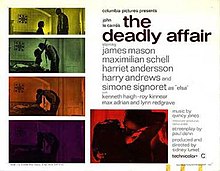The Deadly Affair
| The Deadly Affair | |
|---|---|
 Theatrical release poster | |
| Directed by | Sidney Lumet |
| Written by | Paul Dehn |
| Produced by | Sidney Lumet |
| Starring | James Mason Harry Andrews Simone Signoret Maximilian Schell |
| Cinematography | Freddie Young |
| Edited by | Thelma Connell |
| Music by | Quincy Jones |
| Distributed by | British Lion-Columbia (UK) Columbia Pictures (US) |
Release dates | October 1966 (UK) 26 January 1967 (US) |
Running time | 115 minutes (UK) 107 minutes (US) |
| Country | United Kingdom |
| Language | English |
The Deadly Affair is a 1966 British espionage–thriller film, based on John le Carré's first novel Call for the Dead. The film stars James Mason, Harry Andrews, Simone Signoret and Maximilian Schell and was directed by Sidney Lumet from a script by Paul Dehn. In it George Smiley, the central character of the novel and many other of le Carré's books, is renamed Charles Dobbs as Paramount, which owned the film rights of their recently filmed The Spy Who Came in from the Cold, had the rights to the Smiley character.[1] The soundtrack was composed by Quincy Jones, and the bossa nova theme song, "Who Needs Forever", is performed by Astrud Gilberto.
Plot
In contemporary London, Charles Dobbs (James Mason) is a staid MI5 operative investigating Foreign Office official Samuel Fennan, a former Communist who apparently commits suicide. Dobbs becomes suspicious when a wake-up call is made to Fennan's home the next morning. While his widow Elsa (Simone Signoret) says it was for her, this is discovered to be a lie. Dobbs then suspects that Elsa, a survivor of an extermination camp, might have some clues, but other officials want Dobbs to drop the case. Dobbs privately links up with retired police inspector Mendel (Harry Andrews) to continue inquiries. As they uncover a network of Communist agents, Dobbs also discovers that his wife Ann (Harriet Andersson) is leaving him for a former wartime colleague in Switzerland, Dieter Frey (Maximilian Schell), who may have used access to her to gain knowledge of Dobbs' movements. Dobbs uses his knowledge of Dieter to set a trap, which proves that Elsa is the spy and Dieter is her control. In a final confrontation, Dieter strangles Elsa and shoots Mendel but is killed bare handed by the enraged Dobbs.
Cast
- James Mason as Charles Dobbs
- Simone Signoret as Elsa Fennan
- Maximilian Schell as Dieter Frey
- Harriet Andersson as Ann Dobbs
- Harry Andrews as Inspector Mendel
- Kenneth Haigh as Bill Appleby
- Roy Kinnear as Adam Scarr
- Max Adrian as Adviser
- Lynn Redgrave as Virgin
- Robert Flemyng as Samuel Fennan
- Leslie Sands as Inspector
- Corin Redgrave as David
- Sheraton Blount as Eunice Scarr (uncredited)
- Michael Brennan as Wolfe the Barman (uncredited)
Production
Location shooting for The Deadly Affair took place in London, in St. James's Park, at the Balloon Tavern and the Chelsea Embankment in Chelsea, in Clapham and Barnes, and in Twickenham. The exterior of Dobbs' house is in St. George's Square, Pimlico.[2]
Director of photography Freddie Young's technique of pre-exposing the colour film negative to a small, controlled amount of light (known as "flashing" or "pre-fogging") in order to create a muted colour pallette was first used in this film.[3] Lumet called the result "colorless color" [4] and it proved influential, being used by other cinematographers such as Vilmos Zsigmond on McCabe & Mrs. Miller.
Awards and honours
The Deadly Affair received five BAFTA Awards nominations, for Best British Film for Sidney Lumet, Best British Screenplay for Paul Dehn, Best British Cinematography (Colour) for Freddie Young, Best Foreign Actress for Simone Signoret, and for Best British Actor for James Mason, but did not win any of the awards.[5]
References
- ^ John le Carré at the NFT The Guardian 5 October 2002
- ^ IMDB Filming locations
- ^ TCM Misc. notes
- ^ Steffen, James "The Deadly Affair" (TCM article)
- ^ IMDB Awards
